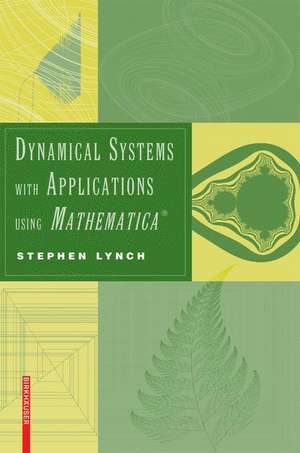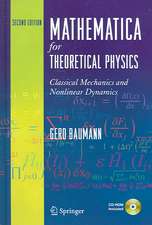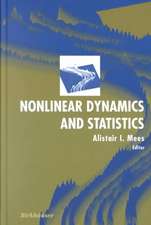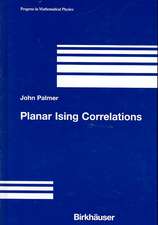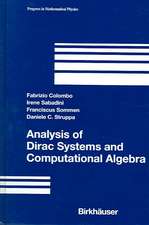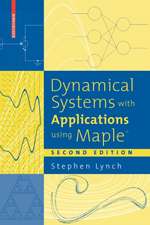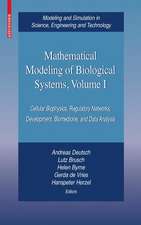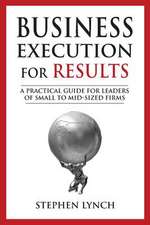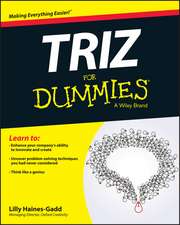Dynamical Systems with Applications using Mathematica®
Autor Stephen Lynchen Limba Engleză Paperback – 30 sep 2007
| Toate formatele și edițiile | Preț | Express |
|---|---|---|
| Paperback (2) | 389.97 lei 38-44 zile | |
| Birkhäuser Boston – 30 sep 2007 | 389.97 lei 38-44 zile | |
| Springer International Publishing – 24 aug 2018 | 456.10 lei 38-44 zile | |
| Hardback (1) | 493.12 lei 38-44 zile | |
| Springer International Publishing – 25 oct 2017 | 493.12 lei 38-44 zile |
Preț: 389.97 lei
Nou
Puncte Express: 585
Preț estimativ în valută:
74.64€ • 81.11$ • 62.74£
74.64€ • 81.11$ • 62.74£
Carte tipărită la comandă
Livrare economică 18-24 aprilie
Preluare comenzi: 021 569.72.76
Specificații
ISBN-13: 9780817644826
ISBN-10: 0817644822
Pagini: 484
Dimensiuni: 155 x 235 x 23 mm
Greutate: 0.69 kg
Ediția:2007
Editura: Birkhäuser Boston
Colecția Birkhäuser
Locul publicării:Boston, MA, United States
ISBN-10: 0817644822
Pagini: 484
Dimensiuni: 155 x 235 x 23 mm
Greutate: 0.69 kg
Ediția:2007
Editura: Birkhäuser Boston
Colecția Birkhäuser
Locul publicării:Boston, MA, United States
Public țintă
ResearchDescriere
This book provides an introduction to the theory of dynamical systems with the ® aid of the Mathematica computer algebra system. It is written for both senior undergraduates and graduate students. The ?rst part of the book deals with c- tinuous systems using ordinary differential equations (Chapters 1–10), the second part is devoted to the study of discrete dynamical systems (Chapters 11–15), and Chapters 16 and 17 deal with both continuous and discrete systems. It should be pointedoutthatdynamicalsystemstheoryisnotlimitedtothesetopicsbutalso- compassespartialdifferentialequations,integralandintegrodifferentialequations, stochastic systems, and time-delay systems, for instance. References [1]–[4] given at the end of the Preface provide more information for the interested reader. The author has gone for breadth of coverage rather than ?ne detail and theorems with proofs are kept at a minimum. The material is not clouded by functional analytic and group theoretical de?nitions, and so is intelligible to readers with a general mathematical background. Some of the topics covered are scarcely covered el- where. Most of the material in Chapters 9, 10, 14, 16, and 17 is at a postgraduate levelandhasbeenin?uencedbytheauthor’sownresearchinterests. Thereismore theory in these chapters than in the rest of the book since it is not easily accessed anywhere else. It has been found that these chapters are especially useful as ref- ence material for senior undergraduate project work. The theory in other chapters of the book is dealt with more comprehensively in other texts, some of which may be found in the references section of the corresponding chapter.
Cuprins
PrefaceA Tutorial Introduction to MathematicaDifferential EquationsPlanar SystemsInteracting SpeciesLimit CyclesHamiltonian Systems, Lyapunov Functions, and StabilityBifurcation TheoryThree-Dimensional Autonomous Systems and ChaosPoincaré Maps and Nonautonomous Systems in the PlaneLocal and Global BifurcationsThe Second Part of David Hilbert's Sixteenth ProblemLinear Discrete Dynamical SystemsNonlinear Discrete Dynamical SystemsComplex Iterative MapsElectromagnetic Waves and Optical ResonatorsFractals and MultifractalsChaos Control and SynchronizationNeural NetworksExamination-Type QuestionsSolutions to ExercisesReferencesMathematica Program IndexIndex
Recenzii
From the reviews:
"Stephen Lynch's book offers a comprehensive introduction to the theory and application of differential equations and dynamical systems methods. Its focus on applications and avoidance of overly technical arguments makes it a an equally good choice for teaching an undergraduate course in dynamical systems, as self-study for graduate students interested in dynamical systems, or as an introductory text for researchers seeking an overview of some current developments in applied dynamical systems. Most importantly, its content and presentation style convey the excitement that has drawn many students and researchers to dynamical systems in the first place.—Dynamical Systems Magazine
"This accessible university text shows how a wide range of differential equations work and begin to fail to work over a very wide range of solved and unsolvable applications. Mathematica is used throughout, from its tutorial introduction in Chapter 0 to the minimally chaotic neuromodule of the final section. This is the first work I have seen in which genuine self-education by computer is expected of the reader. The one-liner programs come to life when typed in, and the growing programming skill lends itself to inventing [one's] own extensions to the supplied problems.—Datafile, The Journal of the HPCC
“The book is a good introduction to dynamical systems theory. … This book presents an original, cheap and powerful solution to the problem of analysis of large data sets. … The text is aimed at graduate students and working scientists in various branches of applied mathematics, natural sciences and engineering. … recommend ‘Dynamical Systems with Applications using MATHEMATICA®’ as a good handbook for a diverse readership, for graduates and professionals in mathematics, physics, science and engineering.” (Damian Trif, Studia Universitatis Babeş-Bolyai. Mathematica, Vol. LIV (4), December, 2009)
"This accessible university text shows how a wide range of differential equations work and begin to fail to work over a very wide range of solved and unsolvable applications. Mathematica is used throughout, from its tutorial introduction in Chapter 0 to the minimally chaotic neuromodule of the final section. This is the first work I have seen in which genuine self-education by computer is expected of the reader. The one-liner programs come to life when typed in, and the growing programming skill lends itself to inventing [one's] own extensions to the supplied problems.—Datafile, The Journal of the HPCC
“The book is a good introduction to dynamical systems theory. … This book presents an original, cheap and powerful solution to the problem of analysis of large data sets. … The text is aimed at graduate students and working scientists in various branches of applied mathematics, natural sciences and engineering. … recommend ‘Dynamical Systems with Applications using MATHEMATICA®’ as a good handbook for a diverse readership, for graduates and professionals in mathematics, physics, science and engineering.” (Damian Trif, Studia Universitatis Babeş-Bolyai. Mathematica, Vol. LIV (4), December, 2009)
Textul de pe ultima copertă
Dynamical Systems with Applications using Mathematica® provides an introduction to the theory of dynamical systems with the aid of the Mathematica computer algebra package. The book has a very hands-on approach and takes the reader from basic theory to recently published research material. Emphasized throughout are numerous applications to biology, chemical kinetics, economics, electronics, epidemiology, nonlinear optics, mechanics, population dynamics, and neural networks.
Mathematica’s symbolic, numerical, and graphical capabilities make it ideal for the study of nonlinear dynamical systems. An introductory chapter provides complete tutorials on how to use Mathematica’s text-based input commands and palettes, enabling new users to become familiar with the program, while providing a good reference source for experts. Working Mathematica notebooks will be available at http://library.wolfram.com/infocenter/Books/AppliedMathematics/.
Throughout the book, the author has focused on breadth of coverage rather than fine detail, with theorems and proofs being kept to a minimum. The first part of the book deals with continuous systems using ordinary differential equations, while the second part is devoted to the study of discrete dynamical systems. Some of the material presented is at the postgraduate level and has been influenced by the author’s own research interests. Exercises are included at the end of every chapter. A comprehensive bibliography including textbooks and research papers rounds out the work.
The book is intended for senior undergraduate and graduate students as well as working scientists in applied mathematics, the natural sciences, and engineering. Many chapters of the book are especially useful as reference material for senior undergraduate independent project work.
Also by the author:
Dynamical Systems with Applications using MATLAB®, ISBN 978-0-8176-4321-8
Dynamical Systems with Applications using Maple, ISBN 978-0-8176-4150-4
Mathematica’s symbolic, numerical, and graphical capabilities make it ideal for the study of nonlinear dynamical systems. An introductory chapter provides complete tutorials on how to use Mathematica’s text-based input commands and palettes, enabling new users to become familiar with the program, while providing a good reference source for experts. Working Mathematica notebooks will be available at http://library.wolfram.com/infocenter/Books/AppliedMathematics/.
Throughout the book, the author has focused on breadth of coverage rather than fine detail, with theorems and proofs being kept to a minimum. The first part of the book deals with continuous systems using ordinary differential equations, while the second part is devoted to the study of discrete dynamical systems. Some of the material presented is at the postgraduate level and has been influenced by the author’s own research interests. Exercises are included at the end of every chapter. A comprehensive bibliography including textbooks and research papers rounds out the work.
The book is intended for senior undergraduate and graduate students as well as working scientists in applied mathematics, the natural sciences, and engineering. Many chapters of the book are especially useful as reference material for senior undergraduate independent project work.
Also by the author:
Dynamical Systems with Applications using MATLAB®, ISBN 978-0-8176-4321-8
Dynamical Systems with Applications using Maple, ISBN 978-0-8176-4150-4
Caracteristici
Book has a very hands-on approach and takes the reader from basic theory to recently published research material
Exercises are included at the end of every chapter
Applications to many disciplines: biology, chemical kinetics, economics, electronics, epidemiology, nonlinear optics, mechanics, population dynamics, and neural networks
The introductory chapter provides complete tutorials on how to use Mathematica’s text-based input commands and palettes
Some of the topics presented are scarcely covered elsewhere
For a broad interdisciplinary readership of undergraduate and graduate students as well as working scientists in applied mathematics, the natural sciences, and engineering
Working Mathematica notebooks available at http://library.wolfram.com/infocenter/Books/AppliedMathematics.
Exercises are included at the end of every chapter
Applications to many disciplines: biology, chemical kinetics, economics, electronics, epidemiology, nonlinear optics, mechanics, population dynamics, and neural networks
The introductory chapter provides complete tutorials on how to use Mathematica’s text-based input commands and palettes
Some of the topics presented are scarcely covered elsewhere
For a broad interdisciplinary readership of undergraduate and graduate students as well as working scientists in applied mathematics, the natural sciences, and engineering
Working Mathematica notebooks available at http://library.wolfram.com/infocenter/Books/AppliedMathematics.
Notă biografică
Stephen Lynch is Senior Lecturer in the Department of Computing and Mathematics at Manchester Metropolitan University.
Also by the author:
Dynamical Systems with Applications using Maple™, ISBN 978-0-8176-4389-8
Dynamical Systems with Applications using MATLAB®, ISBN 978-3-319-06819-0
Also by the author:
Dynamical Systems with Applications using Maple™, ISBN 978-0-8176-4389-8
Dynamical Systems with Applications using MATLAB®, ISBN 978-3-319-06819-0
